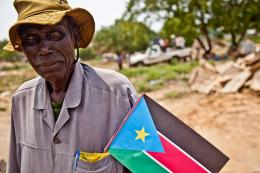
Testimony of John Prendergast, Co-Founder of Enough Project
Senate Foreign Relations Committee
The Situation in South Sudan
January 9, 2013
Thank you, Chairman Menendez and Ranking Member Corker, for the opportunity to testify at this turning point for South Sudan. The full committee's dedicated attention to this issue is very helpful. This body – including your predecessors Senators Kerry and Lugar – has played a pivotal role in the development of U.S. policy on both Sudans, and it is good that is continuing.
I would like to focus my prepared remarks on the way forward for South Sudan. The U.S. government has already shown a welcome level of attention and engagement on this issue. Still, there is always much more that can and should be done to help stop the fighting, secure a durable peace, protect civilians, hold perpetrators accountable, and start to heal this new country in its rocky process of state formation.
Before I begin, I want to reveal a controlling bias in my testimony. I believe that the U.S. and broader international community can finally learn the lessons from past failed peace efforts, and that a new process can evolve in Addis Ababa that takes into account the structural and substantive deficits of previous initiatives. And I believe that the U.S. can play a crucial role in helping to construct a more effective process, and then help build the international leverage necessary to see it through to successful completion.
What needs to happen to forge a negotiated political solution?
The “good” news is that we already know what doesn’t work. We have seen too many peace conferences that kept civil society, religious leaders, grassroots activists and women out of the room. Our collective experience has shown that partial and non-inclusive peace agreements that are negotiated among only those with the biggest guns don’t lead to lasting peace. Additionally, superficial power-sharing agreements don’t work if they do not include professional, transparent and well-funded efforts at army reform and the demobilization and reintegration of former combatants back into society. South Sudan’s struggle to establish its own national reconciliation and dialogue process offers a vivid example of the need to address these issues within the text of binding peace agreements too. Otherwise, DDR, SSR and TRCs just become buzzword acronyms without any impact.
The 2005 Comprehensive Peace Agreement stopped the fighting between Khartoum and the Sudan People’s Liberation Movement in the South. In terms of providing a stoppage of the primary North-South war, it was successful. But the internal wars within North and South were left unaddressed. Deadly conflict has re-erupted in Darfur, South Kordofan and Blue Nile, with Darfur last year having one of the highest rates of newly displaced people in the world. Similarly, the Comprehensive Peace Agreement and what followed did not tackle the deep fissures within South Sudan itself, particularly within the ruling party and the army, but also between local communities who had borne the brunt of the war.
What is needed to address the crisis in South Sudan is a broad expansion beyond the approach taken by those who negotiated the Comprehensive Peace Agreement, and those that are trying to broker isolated deals in Darfur, the Nuba Mountains and Blue Nile, and Eastern Sudan. In South Sudan, of course a deal between the combatant forces for a cessation of hostilities is a first order priority, but what follows needs to be much more inclusive, transparent, and multi-layered than any of the processes that have come before if sustainable peace is to have a chance in South Sudan. This requires a broadening of both substance and structure.
In terms of structuring talks for a lasting political solution, the South Sudan peace process will have to become much more inclusive. Women and youth, who have been notably absent from the Addis process, must be welcomed. The release of the eleven senior level ruling party officials being detained by their government, representing significant political constituencies, and their subsequent involvement in Addis will be essential for the credibility of these talks. Church leaders who have played a major role in previous communal reconciliation initiatives need to be part of the process as well. Furthermore, it will be necessary over time to find a way to engage potential spoilers, whether armed groups or disaffected constituencies from different regions in South Sudan.
South Sudanese have already gone through an extensive consultative process around the New Deal Compact, which focused on both peacebuilding and state-building goals. Additionally, the National Democratic Institute conducted a nationwide survey on views about the constitution. Most recently, 1,200 people were surveyed by the South Sudanese NGO, the Community Empowerment for Progress Organization at the end of December 2013, after fighting started in Juba. Among other questions, they were asked their views on the road map for peace and stability in South Sudan. These efforts have already gathered valuable perspectives from those most affected by the violence: civilians and average citizens. Negotiators should take them into account.

